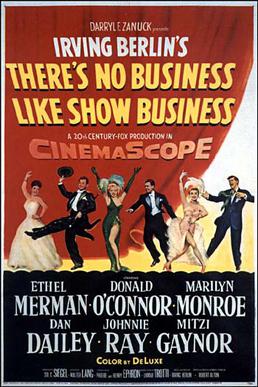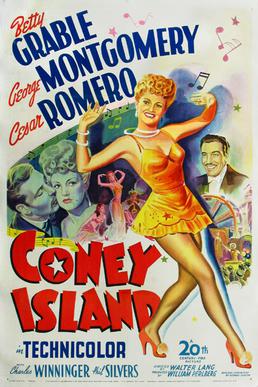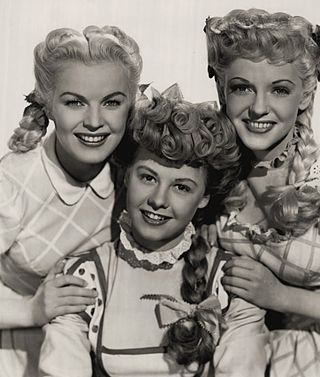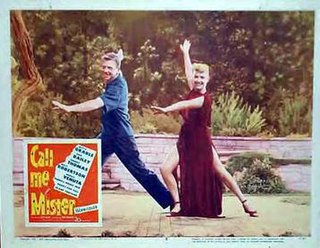
Elizabeth Ruth Grable was an American actress, pin-up girl, dancer, model and singer.

Harry Warren was an American composer and the first major American songwriter to write primarily for film. He was nominated for the Academy Award for Best Original Song eleven times and won three Oscars for composing "Lullaby of Broadway", "You'll Never Know" and "On the Atchison, Topeka and the Santa Fe". He wrote the music for the first blockbuster film musical, 42nd Street, choreographed by Busby Berkeley, with whom he would collaborate on many musical films.
Harry Revel was a British-born American composer, mostly of musical theatre, working with various lyricists, notably Mack Gordon. He is also seen as a pioneer of "space age pop".

Irving Berlin's There's No Business Like Show Business is a 1954 American musical comedy-drama film directed by Walter Lang. It stars an ensemble cast, consisting of Ethel Merman, Donald O'Connor, Marilyn Monroe, Dan Dailey, Johnnie Ray, and Mitzi Gaynor.

The Gang's All Here is a 1943 American Twentieth Century Fox Technicolor musical film starring Alice Faye, Carmen Miranda and James Ellison. The film, directed and choreographed by Busby Berkeley, is known for its use of musical numbers with fruit hats. Included among the 10 highest-grossing films of that year, it was at that time Fox's most expensive production.

I Wake Up Screaming is a 1941 film noir. It is based on the novel of the same name by Steve Fisher, adapted by Dwight Taylor. The film stars Betty Grable, Victor Mature and Carole Landis, and features one of Grable's few dramatic roles.

Orchestra Wives is a 1942 American musical film by 20th Century Fox starring Ann Rutherford, George Montgomery, and Glenn Miller. The film was the second film to feature The Glenn Miller Orchestra, and is notable among the many swing era musicals because its plot is more serious and realistic than the insubstantial storylines that were typical of the genre. The movie was re-released in 1954 by 20th Century Fox to tie-in with the biopic The Glenn Miller Story.
"I Had the Craziest Dream" is a popular song which was published in 1942. The music was written by Harry Warren, the lyrics by Mack Gordon.

Down Argentine Way is a 1940 American musical film made in Technicolor by Twentieth Century Fox. It made a star of Betty Grable in her first leading role for the studio although she had already appeared in 31 films, and it introduced American audiences to Carmen Miranda. It also starred Don Ameche, The Nicholas Brothers, Charlotte Greenwood, and J. Carrol Naish.

Coney Island is a 1943 American Technicolor musical film released by Twentieth Century Fox and starring Betty Grable in one of her biggest hits. A "gay nineties" musical, it also featured George Montgomery, Cesar Romero, and Phil Silvers, was choreographed by Hermes Pan, and was directed by Walter Lang. Betty Grable also starred in the 1950 remake, Wabash Avenue.

Second Honeymoon is a 1937 American screwball romantic comedy film directed by Walter Lang and starring Tyrone Power, Loretta Young and Stuart Erwin. Based on a story by Philip Wylie it was distributed by Twentieth Century-Fox. A comedy of remarriage, it was overshadowed by the similar The Awful Truth released the same year.

Mother Wore Tights is a 1947 American Technicolor musical film starring Betty Grable and Dan Dailey as married vaudeville performers, directed by Walter Lang.

Week-End in Havana is a 1941 20th Century Fox Technicolor musical film directed by Walter Lang and starring Alice Faye and Carmen Miranda. It was the second of three pictures the two stars made together and the second Faye film to have a Latin-American theme, typical of Fox musicals of the early 1940s. Faye was pregnant during filming.

"(I've Got a Gal in) Kalamazoo" is a #1 popular song recorded by Glenn Miller and His Orchestra in 1942. It was written by Mack Gordon and Harry Warren and published in 1942. It was featured in the musical film Orchestra Wives and was recorded by Glenn Miller and His Orchestra, featuring Tex Beneke, Marion Hutton and The Modernaires, who released it as an A side 78 in 1942, 27934-A. The B side was "At Last".

Pin Up Girl is a 1944 American Technicolor musical romantic comedy motion picture starring Betty Grable, John Harvey, Martha Raye, and Joe E. Brown.

Diamond Horseshoe is a 1945 Technicolor musical film starring Betty Grable, Dick Haymes and William Gaxton, directed by George Seaton, and released by 20th Century Fox. It was filmed in Billy Rose's Diamond Horseshoe, a nightclub located in the basement of the Paramount Hotel. The film's original score is by Harry Warren and Mack Gordon, introducing the pop and jazz standard "The More I See You".

Wabash Avenue is a 1950 American musical film directed by Henry Koster and starring Betty Grable. The film was a remake of Grable's earlier hit 1943 film Coney Island.

Something for the Boys is a 1944 musical comedy film directed by Lewis Seiler. It stars Carmen Miranda, with Michael O'Shea, Vivian Blaine, Phil Silvers, Sheila Ryan and Perry Como.

Three Little Girls in Blue is a 1946 American Technicolor musical film directed by H. Bruce Humberstone and starring June Haver along with George Montgomery, Vivian Blaine, Celeste Holm, and Vera-Ellen. The 20th Century-Fox film was adapted from Stephen Powys' 1938 play Three Blind Mice and featured songs with music by Josef Myrow and lyrics by Mack Gordon. The score is notable for the first appearance of the song "You Make Me Feel So Young".

Call Me Mister is a 1951 American Technicolor musical film released by Twentieth Century-Fox. The feature was directed by Lloyd Bacon and re-written from the 1946 Broadway play version by Albert E. Lewin and Burt Styler with music by Harold Rome that featured cast members from the US armed forces.



















